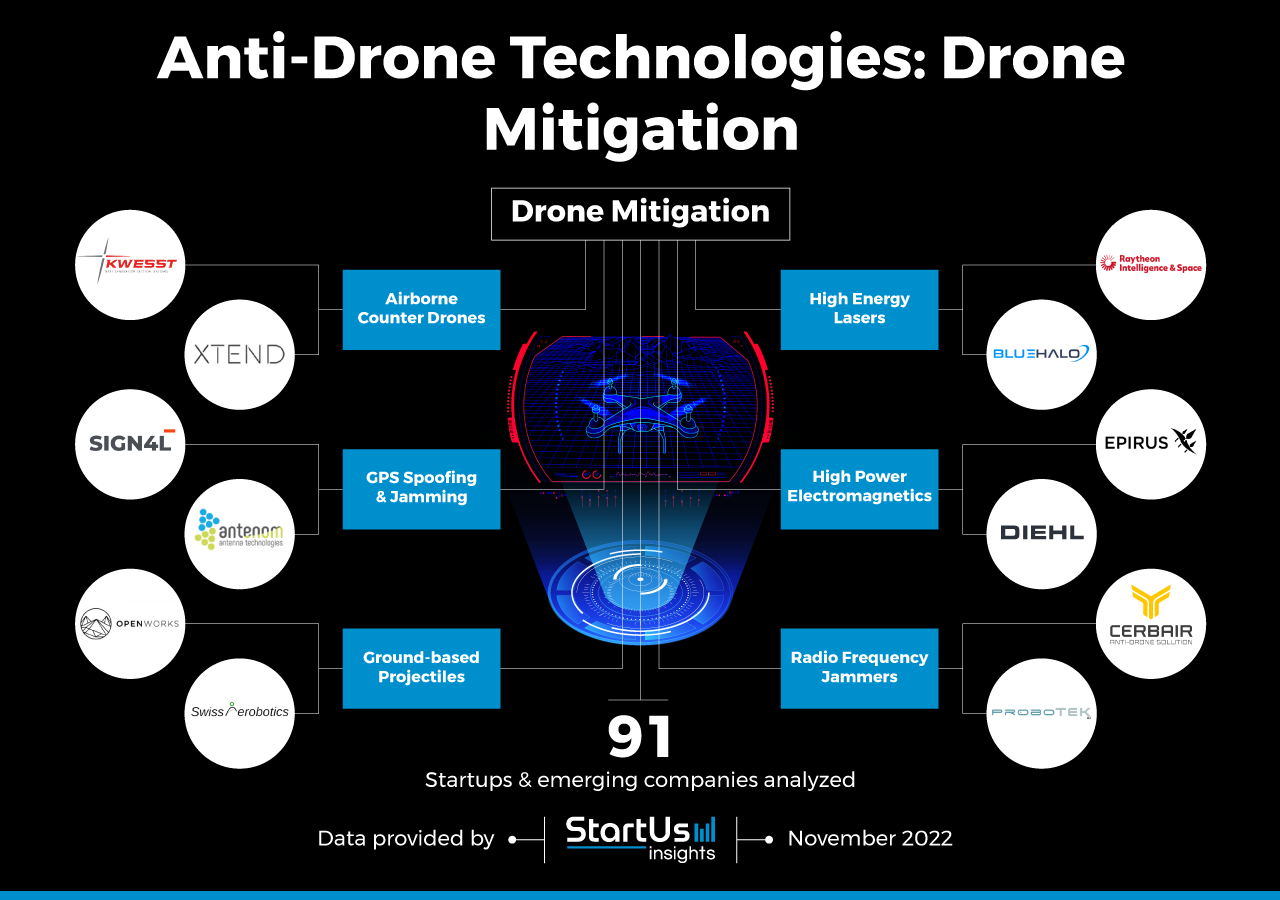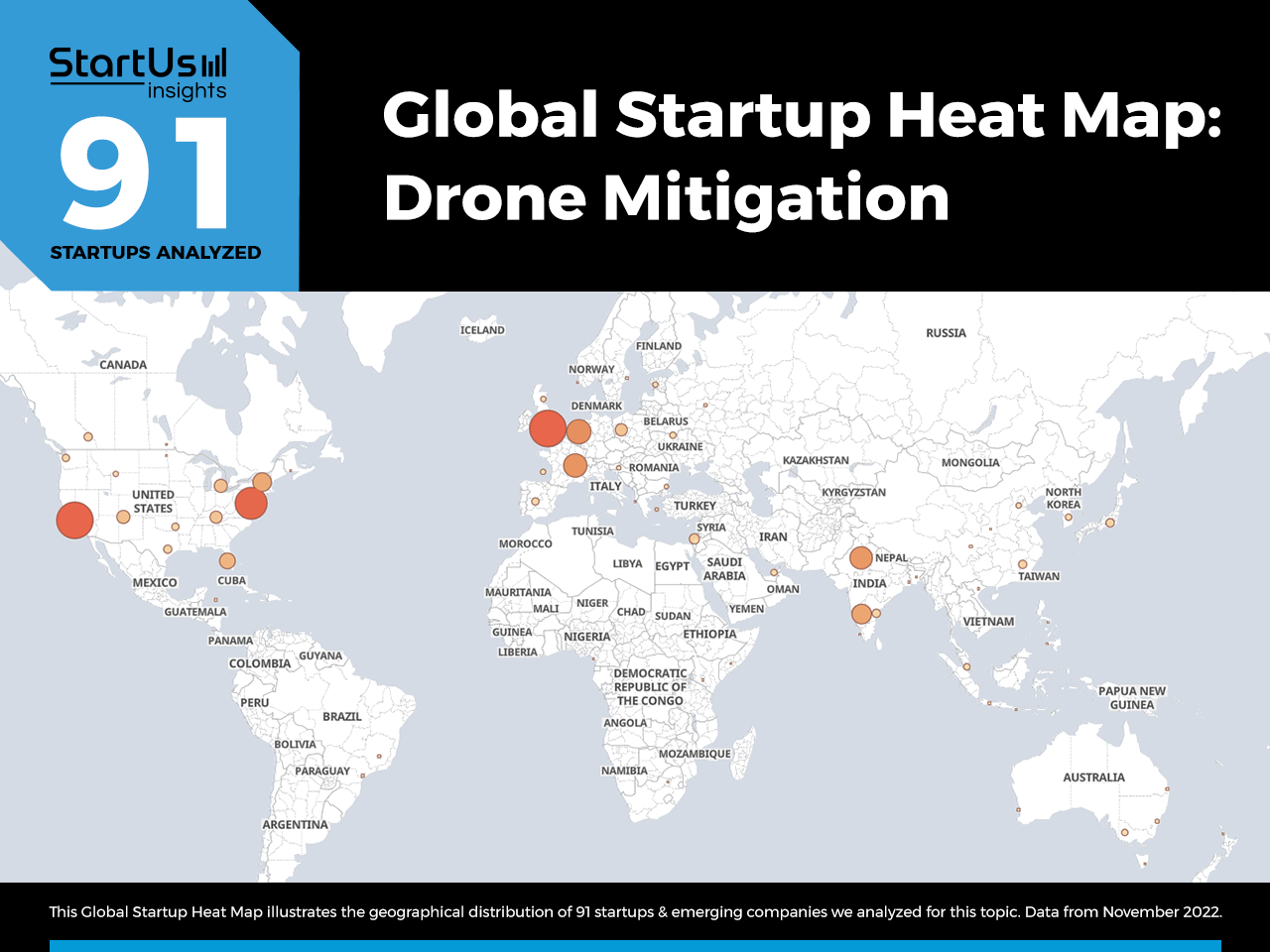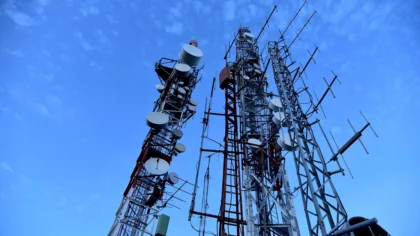Accelerate Productivity in 2025
Reignite Growth Despite the Global Slowdown
Recent developments in the Russia-Ukraine war have generated a renewed interest in counter-unmanned aerial systems (C-UAS). With the Russian forces resorting to inexpensive combat drones, loitering munitions, cruise missiles, and kamikaze drones, the safety of military personnel, civilians, and critical infrastructure is compromised. This makes the detection and neutralization of these rogue UAVs very important to counter the unscrupulous use of unmanned weaponry. Solutions offering early detection of such threats were discussed in our previous article on drone detection technologies. However, to ensure complete protection, strategies to take down combat drones are equally important.
Even though traditional ammunition like guns and ballistic missiles are reliable agents for neutralizing air-borne targets, the scale and flexibility of cheap drones and loitering munitions render them uneconomic and unsafe. With reconnaissance drones and unmanned combat aerial vehicles (UCAVs) taking low-altitude flight paths as is the case in the Ukraine war, any hits with a conventional system might cause the UAV to spiral out of control wreaking havoc. This has led military tech startups and scaleups to develop drone countermeasures at a lower cost and inflict zero danger to innocent bystanders. The low cost of drone mitigation technologies also provides a way to overcome the asymmetrical nature of saturation attacks.
The drone mitigation equipment utilizes the same technologies that advance drone flight to disrupt its flying and land it safely. These countermeasure techniques either physically impede drone flight, destroy flight electronics, or even take control of the flight. This creates two main methods of drone mitigation namely: kinetic and non-kinetic. Kinetic methods utilize effectors like projectiles and nets that destroy the rotors or flight aids pinning them to the ground safely. Non-kinetic countermeasures prevent secondary crisis landing or crashing by either taking control of the drone and landing it safely, or by misguiding the navigation system of the drone to another location or its origin location. This article takes you through the various drone neutralization technologies that facilitate the safe mitigation of UAV threats.
Innovation Map outlines the Top 12 Systems to Mitigate Combat Drones
For this in-depth research on the Top Anti-Drone Technologies & Startups, we analyzed a sample of 91 global startups & scaleups. The result of this research is data-driven innovation intelligence that improves strategic decision-making by giving you an overview of emerging technologies & startups in the military industry. These insights are derived by working with our Big Data & Artificial Intelligence-powered StartUs Insights Discovery Platform, covering 2 500 000+ startups & scaleups globally. As the world’s largest resource for data on emerging companies, the SaaS platform enables you to identify relevant startups, emerging technologies & future industry trends quickly & exhaustively.
In the Innovation Map below, you get an overview of the Top 6 Anti-Drone Technologies to Mitigate Combat Drones. Moreover, the Anti-Drone Technologies: Drone Mitigation Innovation Map reveals 12 hand-picked startups, all working on emerging technologies that advance their field.
Top 6 Technologies to Mitigate Combat Drones
- Ground-based Projectiles
- High Energy Lasers
- Airborne Counter Drones
- Radiofrequency Jammers
- GPS Spoofing and Jamming
- High Power Electromagnetics
Global Startup Heat Map covers 91 Drone Mitigation Startups & Scaleups
The Global Startup Heat Map below highlights the global distribution of the 91 exemplary startups & scaleups that we analyzed for this research. Created through the StartUs Insights Discovery Platform, the Heat Map reveals that the US & Western Europe see the most startup activity.
Below, you get to meet 12 out of these 91 promising startups & scaleups as well as the solutions they develop. These 12 startups are hand-picked based on criteria such as founding year, location, funding raised, & more. Depending on your specific needs, your top picks might look entirely different.
Top 6 Anti-Drone Technologies to Mitigate Combat Drones
1. Ground-based Projectiles
Ground-based kinetic countermeasures are referred to as “hard kills”. Hard kill technology encompasses projectile weapons that physically damage the drone or knock it to the ground. These kinetic methods include nets, bullets, or missiles. The most effective technique in this counter technology involves firing a net at a drone or otherwise bringing a net into contact with a drone that stops the drone by prohibiting the rotor blades. This method physically captures drones good for forensics and prosecution. The ground-launched net cannons are usually semi-automatic with high accuracy. Some net-based also offer a parachute with the net, which facilitates a soft landing for armed drones and loitering munitions.
OpenWorks offers Autonomous Drone Capture
UK-based startup OpenWorks develops security and counter-terrorism technologies. The startup’s SkyWall Auto autonomous counter-drone system uses edge AI to autonomously track and acquire enemy UAVs. It rapidly captures multiple targets using accurately-delivered nets and is remotely operable after being installed on a building or a moving vehicle. Further, the autonomous drone capture solution deploys electronic countermeasures in conjunction with a layered defense system.
Swiss Aerobotics provides Net Guns
Swiss startup Swiss Aerobotics designs and develops custom counter-drone technologies for various drone-related applications. Deinopsys is their counter-UAS technology that utilizes a patent-pending net-thrower cartridge. The Deinopsys Mark1 Netgun shoots multiple times without reloading and stops drones safely with a parachute. The net gun in this way stops combat drones safely up to 30 meters and beyond.
2. High-Energy Lasers
Due to the high cost of missiles and other weaponized projectiles, directed energy systems offer an alternative for such expensive solutions to shoot down combat drones. A high-powered optical device that produces an extremely focused beam of light or laser beam by destroying the structure and/or the electronics. In this way, a high-energy laser is a comparatively affordable and viable option to protect military and critical infrastructure, and rapidly defeat threats. These laser effectors in integration with drone detection systems like optical and radar systems form an autonomous system to take down battlefield UAVs. But the uncontrolled descent of the target makes it unsuitable for use in populated areas.
Raytheon Intelligence & Space develops High Energy Laser Systems
US-based company Raytheon Intelligence & Spaces develops advanced sensors, training, and cyber and software solutions for military applications. Raytheon’s high-energy laser system uses photons to carry out military missions and civil defense. This mitigation system involves a low cost-per-shot ratio, lasers offer a nearly infinite number of shots, minimal logistics, and precision accuracy with very low collateral damage. It also includes automated cueing with the aid of a full spectrum electro-optical/infrared sensor system, reducing operator workload and time of engagement.
BlueHalo builds Directed Energy C-UAS Platforms
US-based startup BlueHalo provides fully integrated directed energy C-UAS platforms. LOCUST is their proprietary laser weapon system that automates drone protection solutions that keeps the skies clear. BlueHalo’s solution uses a scalable high-energy laser effector to deliver a hard kill. In addition, the AI-enabled ARGUS system provides a turnkey system that detects combat UAV intrusions and ensures maximum accuracy for each laser shot.
3. Airborne Counter Drones
Ground-based kinetic systems although effective pose the danger of being attacked once detected by the enemy. This endangers the safety of the operator controlling these systems. The improvements in the payload capacities of drones allow taking a detection and effector system to the skies. These airborne systems track and destroy the invading combat drones by physically striking them down. This technique requires reactive and real-time decision-making, accurate target flying path estimation, and outstanding physical durability and mobility. It also allows for better visibility into flight activities in an area, enabling swift counterattacks to mitigate combat drones. A swarm of these killer drones with distributed intelligence and precise tracking systems offers a promising solution for drone fleet multi-faceted attacks.
KWESST develops Autonomous Counter Drones
Canadian company KWESST develops and commercializes technologies that deliver a tactical advantage for military, security forces, and personal defense. TASCS is their soldier-launchable micro-drone for kinetic interdiction of small drones, loitering munitions, and even swarms. KWESST’s fully autonomous counter-drone system identifies and locks on rogue combat drones to track, hunt, and neutralize them with kinetic impact.
XTEND offers Air-borne Effectors
Israeli startup XTEND offers a C-UAS system that enables kinetic interception of suicide drones or any other rogue flying objects. Griffon, the startup’s air-borne effector, enables any operator without flight experience to launch and intercept target drones within seconds of recognition. The startup’s drone system is configured and optimized for multi-rotor interception. It also supports a modular architecture capable of eliminating fixed-wing elements with a dedicated effector.

4. Radio Frequency Jammers
Radio frequency (RF) signals are the lifeline between a drone and its controller. An RF jamming system paralyzes the radio communication between the target drone and its controller to make it uncontrollable by using more powerful interfering RF signals. Jamming the drone-controller link makes it lose control of the ‘auto-home’ facility, and gives control to the jammer. These jamming systems can be directional or omnidirectional. In directional jamming, the power is confined spatially, decreasing the possibility of interference with the co-located RF devices/equipment compared to omnidirectional jammers. The RF jamming is also modular and scalable allowing stationary jammers installed at a fixed location and mobile jammers operating from portable devices that are handheld or vehicle-mounted.
Probotek offers RF jamming Guns
Greek startup Probotek provides enterprise solutions in the information technology and defense sectors. The DroneGun MkIII is the startup’s compact, lightweight drone countermeasure that offers a safe defense against a wide range of combat drones. The gun utilizes RF disruption activation interfering with any live video streaming back to the remote controller halting the collection of video footage and intelligence by the drone operator. DroneNode is another solution that corrupts the flight control RF bands that makes enemy drones either return to their point of origin or land at a specified location.
Cerbair neutralizes Drones with Electromagnetic Jamming
French startup Cerbair develops anti-drone solutions that allow the detection, characterization, and neutralization of enemy combat drones. Medusa, the startup’s neutralization solution, uses electromagnetic jamming to trigger the emergency procedure of rogue drones. Hydra, Cerbair’s RF analysis platform, correctly identifies the operating RF band and sends out the appropriate RF emissions automatically, minimizing interferences with other friendly drones.
5. GPS Spoofing & Jamming
Autonomous UCAVs and loitering munitions rely on global positioning systems (GPS) and global navigation satellite systems (GNSS) for location and navigation. Using fake GPS signals to spoof communication with the satellites, thus, disrupts drone movements. The drone is ‘spoofed’ into thinking it’s somewhere else and loses control of the auto-home facility and is hijacked and diverted to the desired zone. Drone hijacking through GPS spoofing facilitates follow-up investigations and other forensic data collection. GPS spoofers are of medium cost, provide non-destructive neutralization, and have a short range.
Sign4L generates Spoof Navigation Paths
UAE-based company SIGN4L, a subsidiary of the EDGE group, provides advanced electronic warfare services and solutions for national security. The company’s GPS spoofing system, NavControl-G, emits counterfeit GNSS signals. This mimics the legitimate signals to generate an alternative path and safely mitigate the threat of hostile combat drones. The spoofing GPS protects a specified area of interest and uses powerful RF amplifiers for extended-range operations. The jamming transmitter also features a shock-proof ruggedized case for use in extreme conditions.
Antenom offers Counter Drone Antennas
Turkish startup Antenom develops counter drone antenna technology to mitigate combat drones in fixed-site and vehicle-type applications. HP-AMHA, the startup’s range right-hand circular polarized axial mode helical antenna features counter-GNSS capabilities. The fiber radome of this antenna makes it mechanically stable and environmentally protected. This facilitates ease of integration into facilities and transport systems that tackle extreme conditions.
6. High Power Electromagnetics
Advances in electronic circuits are opening up new options for lightweight drones and loitering munitions. Devices capable of generating high-power electromagnetic pulses (EMPs) disrupt the electronic components of the drone. The EMPs disrupt or even destroy the electronic circuitry by inducing damaging voltages and currents. As a result, the targeted drone falls uncontrolled instantly. These devices use an antenna to focus the EMPs in the required direction to reduce the potential collateral damage.
Epirus develops Counter Electronics
US-based startup Epirus develops solid-state, software-defined directed energy systems that enable counter-electronic effects in defense and commercial applications. Leonidas is their solid-state, software-defined high-power microwave that neutralizes combat drone threats by interrupting their electronics. Epirus’ technology is scalable and modular allowing integration into both fixed and mobile systems. The Leonidas mobile mounts on the back of ground combat vehicles bring counter-UAS and counter-swarm capabilities to the frontlines.
Diehl Defence creates High-Power Countermeasures
Austrian company Diehl Defence offers products and services that aid the protection of armed forces and their equipment. The company develops a high-power electromagnetic (HPEM) effector system to counter combat drones and other enemy UAVs. The high-energy EM pulses that the effector system sends out interfere with the electronic systems. The HPEM system poses no health hazard to users and uninvolved individuals.
Discover all Anti-Drone Technologies, Trends, & Startups
Drone-based warfare is the human race’s first step towards efficient unmanned combat. Further, all innovations point to a future with highly agile and untraceable UAVs and loitering munitions. The counter-drone solutions discussed above represent the most popular defensive and offensive capabilities of UAVs. These solutions keep open the possibilities of further innovation through the adoption of deep learning, blockchain, and cybersecurity innovations. They allow for better pattern recognition, data security, and improved decrypting and encrypting powers.




![Explore the Top 10 Waste Management Industry Trends & Innovations [2025]](https://www.startus-insights.com/wp-content/uploads/2025/06/Waste-Management-Industry-Trends-SharedImg-StartUs-Insights-noresize-420x236.webp)




